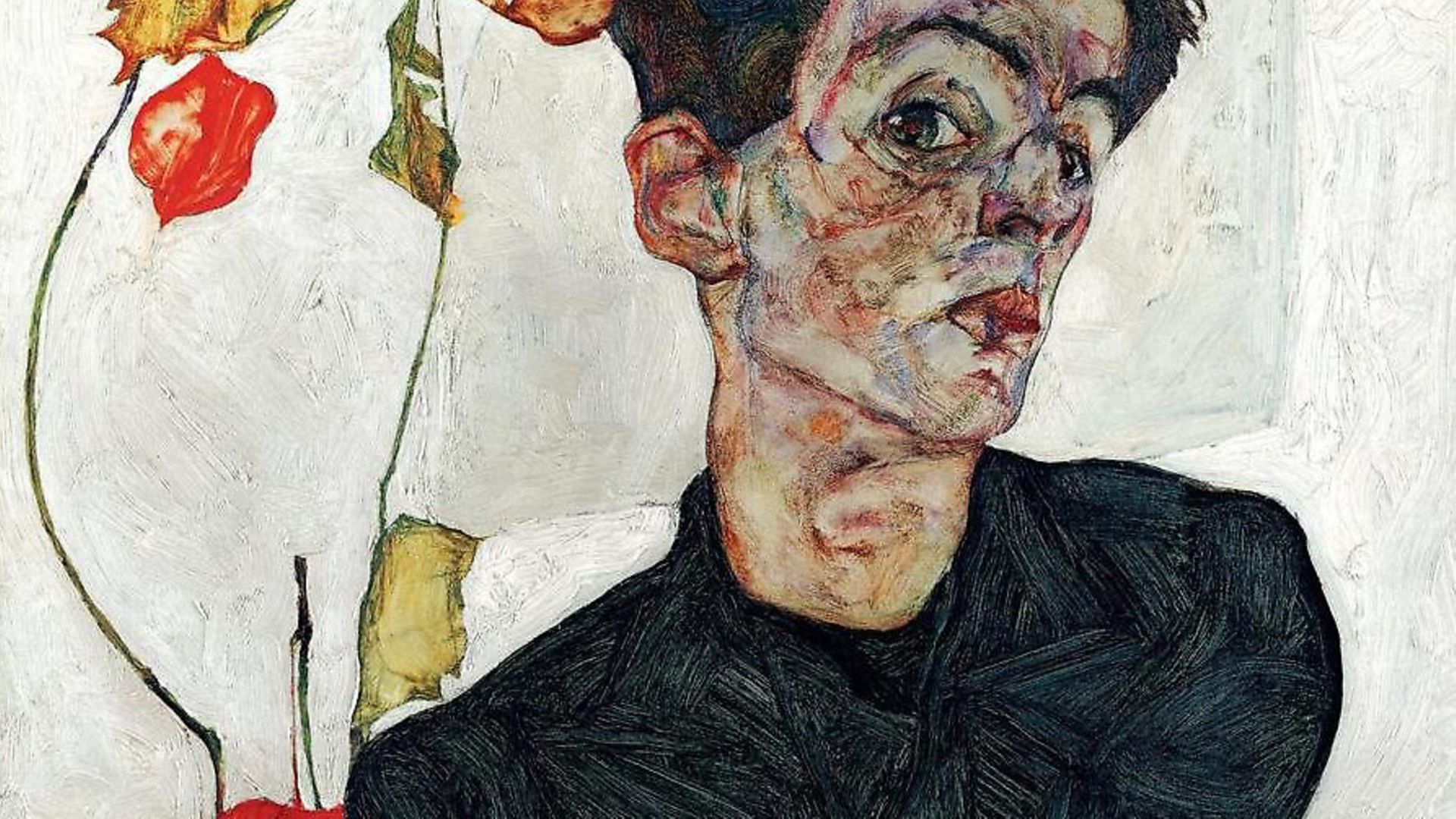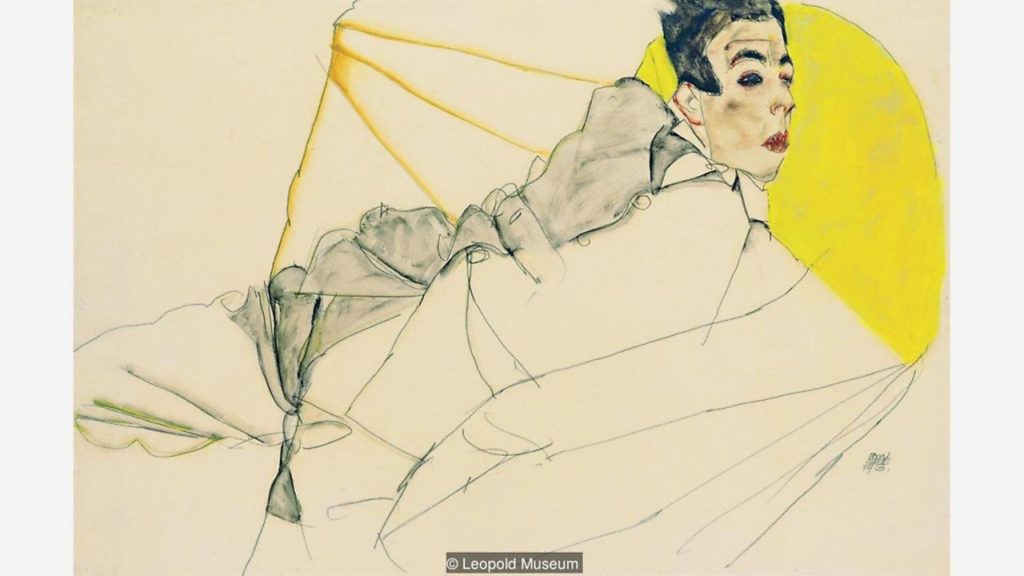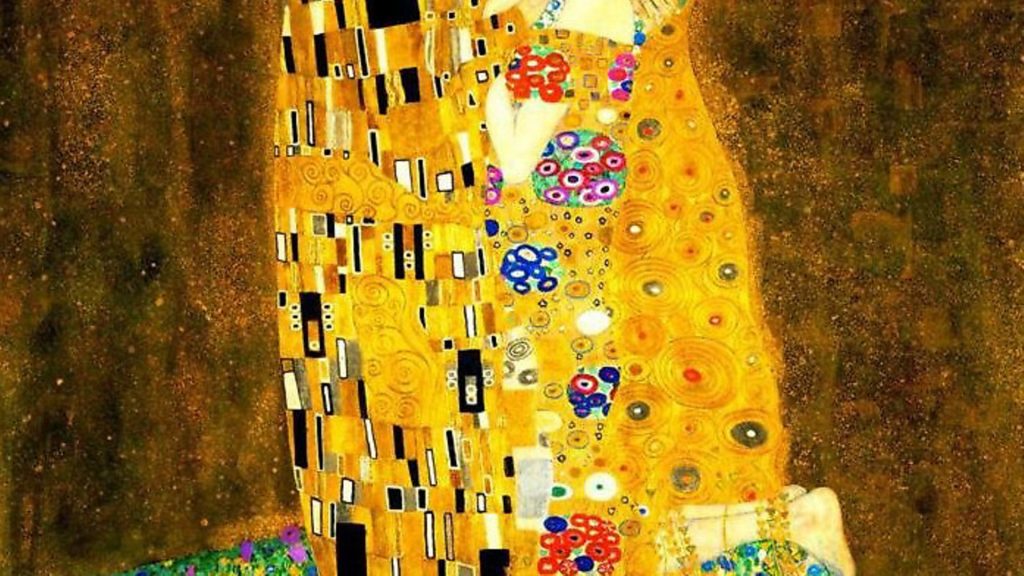
In a year of blockbuster exhibitions and events, Vienna is celebrating the period when it was the controversial cultural capital of the world.

Anyone who travelled on the London Underground earlier this year will have noticed the huge advertisements featuring Egon Schiele’s controversial nudes replete with a white banner covering their genitalia that proclaimed: ‘SORRY, 100 years old but still too daring today. #To Art its Freedom: Viennese Modernism 2018. See it all in Vienna.’
Initially, the ads were rejected by marketers in both the UK and Germany due to regulations governing ‘morality in the public domain’. Only when the Viennese Tourist Board covered up the nude’s offending private parts were the displays allowed.
The adverts were a fittingly risqué promotion for Vienna’s massive year-long, city-wide enterprise – Beauty and the Abyss – a series of exhibitions to honour the centenary of the deaths of four of the city’s most famous sons (artists Gustav Klimt, Egon Schiele and Koloman Moser and the architect Otto Wagner), as well as celebrate the influence of fin de siècle Viennese Modernism and the end of the Viennese Secession.
All four men are synonymous with Modernism and especially the Secession, on whose headquarters – an exhibition pavilion on Vienna’s Friedrichstrasse – sits that hashtagged aphorism in full, Der Zeit ihre Kunst. Der Kunst ihre Freiheit – ‘To every age its art. To every art its freedom’.

The furore caused by the posters is, of course, entirely appropriate since Vienna circa 1900 was one of the naughtiest, most liberated cities in the world, where every distraction was available and every controversy courted. It was during this period that the city’s best-known art, architecture and design masterpieces were created, music composed and notions conceived. Back then, Vienna was not just the geographical centre of Europe and the capital of the continent’s biggest political entity, the Austro-Hungarian empire, boasting some 11 chief ethno-language groups, it was also a melting pot of cultures, philosophies and arcane mischief.
What is less appropriate is that the Secession’s maxim should have been purloined by Austria’s current government, a union of the centre-right People’s Party and far-right Freedom Party founded in the 1950s by previous Nazi bureaucrats. Their coalition agreement is contained in an 182-page document, which includes a section on their plans for culture, and how freedom for the arts is a given, while also stating ‘engagement with our common cultural heritage […] contributes significantly to Austria’s sense of identity’. But, what has really got the Viennese art cognoscenti’s goat is that the Secession’s almost sacred motto, ‘To every time its art, to art its freedom’, is also used in the manifesto. In answer, the Secession board (who are still very active, with ground-breaking exhibitions) issued a public declaration that included the following: ‘Freedom of the arts is necessarily premised on internationality, pluralism, and dialogue. The notion that art’s purpose is to buttress a national collective identity presses it into a service that runs counter to its thematic diversity […] An open society is the air that art needs to breathe.’
Certainly, when we think of Vienna circa 1900 we don’t think of jingoist right wing politics. We think of Sigmund Freud, the son of a Jewish Moravian who pioneered psychoanalysis, the great composer Gustav Mahler born in Bohemia, Jewish 12 tone composer Arthur Schoenberg, of Bratislavan parenthood whose work was considered decadent by the Nazis, and of Joseph Maria Olbrich, the Silesian architect who created the Secession building. One might contest that this concoction of influence, this open mindedness that was fin de siècle Vienna is responsible for creating our modern multi media, multi national, multi faceted world – sitting on a chair a Koloman Moser chair, looking at a Klimt painting while listening to Mahler and thinking about Freud.
This liberal ethic lay at the heart of the Viennese Secession, which included Olbrich, Klimt – who was the society’s first president – illustrator Max Kurzweil, designer Josef Hoffmann and all rounder Moser, who designed everything from stamps to jewellery to stained glass windows and clothing.
Undoubtedly, these Viennese visionaries were hugely influenced by the Britain’s Aesthetic Movement. And while the Brits rebelled against the rapacious industrialisation of their country, so did the Secession revolt against the conformist, reactionary Austro-Hungarian Empire and its lap dog, the Vienna Künstlerhaus (Artist’s Society), who foiled any attempt to show either foreign or avant-garde art in their country.
Consequently, the vehemently internationalist Secession fielded exhibitions of arts, photography and crafts from far and wide. Glasgow’s Charles Rennie Mackintosh and his wife Margaret MacDonald exhibited at the eighth Secession in 1900, mad cap expressionist dancer Isadora Duncan performed in their building while the gang themselves were proud to count Polish painter, artist and poet Stanislaw Wyspianski, Russian painter Teresa Feoderovna Ries and Hungarian architectural sculptor Othmar Schimkowitz (who created the three Gorgons on the Secession building) amongst their number. Not surprisingly, all this free thinking modernity and fraternizing with foreigners ruffled a few feathers but, as hard as the wheezing old guard huffed and puffed, they could not blow the Secession House down.
To put the Secession in context, the clique were not unlike Brit punk rockers of the 1970s in that they, deliberately contentious and controversial, created a new style of ‘art’ for the people, by the people. So teachers preached against them, the press ridiculed them and clerics called them the Anti Christ, while they just carried on regardless, held their own events, made their own posters and published their house magazine, Ver Sacrum (Sacred Spring) which featured reproductions, poetry, illustrations, graphic art and object design. The Secession helped Vienna throw off the shackles of 19th century inhibition and march into the new century like a lusty teenage libertine.
A city that proffered all manner of distractions, Vienna in 1900 vied with Paris as the hedonist’s paradise. Prostitution of all kinds was rife sparking numerous appeals by upstanding citizens who decried Vienna’s descent into so called dissolution and depravity. The city became known as the homosexual capital of Europe, its numerous public bath houses renowned throughout the empire as the premier hang out for well heeled urbane gay male. As Magnus Hirschfeld, the Berlin-based pioneer of the German gay movement wrote in a 1901 article regarding the flourishing secret homosexual life of Vienna: ‘We saw men whose appearance gave nothing away, and others in make-up, powdered and decorated with beauty spots and dripping with real or fake diamonds […] there whooped a group of 18-20-year-olds full of the joy of youth, playfully teasing each other with girls’ names.’ Alternatively lesbian women were catered to by Sapphic cabaret at the likes of Eisvogel, one of the largest revue bars in the Prater, and its ladies-only orchestra.
To add to this free-for-all, no hold barred society Diacetylmorphine – sold over the counter under its well-known trademark (Heroin) as ‘the sedative for coughs’ – was as common as Paracetamol. And, as they were yet to discover its hugely addictive qualities, heroin addiction was so rife that doctors prescribed the easily available cocaine as a cure. Sigmund Freud was all over the marching powder and published his papers, Über Coca, as early as 1884 in which he wrote about the marvellous effects of cocaine: ‘It causes exhilaration and lasting euphoria which in no way differs from the normal euphoria of the healthy person,’ he wrote. It’s hard to imagine the high jinx as folk discovered the fun they might have with these new pharmaceutically pure wonder drugs considered not only harmless but also beneficial. Add the fashionable yet mind-altering absinthe to the mix, shake vigorously, and the consequences were hardly mundane.
And leading the charge was the Secession, created in 1897, and any celebration of Viennese creativity should focus on the group, especially Klimt, Schiele, Wagner and Moser as each played a unique role, in not only the city’s, but also the world’s aesthetic.
Its most famous member is Klimt (his work Portrait of Adele Bloch-Bauer is the 13th most expensive painting ever sold, at $158.7 million) and he epitomised the crew’s tenet by smashing every convention to smithereens. In 1888, aged 26, he was the establishment golden boy and received the Golden Order of Merit from Emperor Franz Josef for his murals but four years later, after his father and brother suddenly died, Klimt created a new style that, mainly paintings of the nude female body, were unashamedly erotic (and, by some standards, pornographic) and surfed the city’s preoccupation with sex that so coloured the work of Freud. Undoubtedly, Klimt was punk rock. He was front-page news. He was controversial beyond the pale. He took traditional themes, added a primitive sexuality orientated sub text and blew the bloody doors off.
After Klimt embarked on his ‘Golden period’ (named so because this was when he painted his most celebrated works and he used a lot of gold leaf) he caused a humongous fuss but embraced a hippy, free-loving lifestyle, wore no under wear, sported long man-dresses, open-toed sandals and a scruffy unkempt beard. He fathered some 14 children with a succession of women – none of whom he married – while his permanent companion, fashion designer Emilie Floge, with her unconstructed, corset-less, free-flowing garments and liberal sexual mores, was a hero of the Viennese feminist movement.
And yet Klimt still had time to encourage others. In 1907, 17-year-old Egon Schiele (who’d previously been ordered not to visit the Secession by his art tutor) met his idol Klimt, who became his mentor. Klimt introduced the absurdly talented teenager to the Wiener Werkstätte (the Secession’s community of artists) and consequently invited him to exhibit in the 1909 Vienna Kunstschau, alongside Edvard Munch and Van Gogh. Schiele took the master’s lead and concentrated on depicting explicit nude figures, employed bar girls and prostitutes as models and had sex with almost all of them. Thus, between 1909 and 1910 Schiele moved from being merely Klimt’s protégé to Austria’s premier Spiesserchreck, or terror of the bourgeoisie.
In 1911, Schiele met the 17-year-old former Klimt model (and supposed mistress) Valerie (Wally) Neuzil and moved with her to his mother’s birthplace, Krumau, where he employed the town’s teenage girls as models, was arrested and charged with seduction and abduction of a minor only for the police to raid his home and confiscate over one hundred ‘pornographic’ drawings and imprison him for three weeks. The more serious charges were dropped, but he was found guilty of exhibiting erotic drawings in a place accessible to children and served another three days in jail.
Indubitably, Schiele’s antics were rather off piste even for the mad house that was Vienna back then and caused uproar even amongst his colleagues. Apart from drawing nude minors from life he also depicted a woman masturbating, while his painting, Eros, portrayed an emaciated naked male with his legs open holding his huge red, erect penis. Still, it wasn’t until after a barnstorming solo show in Paris artist in 1914 that the international art world suddenly twigged to the man’s inestimable genius.
But the Secession was not just about nude paintings, it was also about innovation and, even though the lives of Koloman Moser and Otto Wagner were not quite so controversial as either Klimt or Schiele, both adequately illustrated the Secession’s will or Gesamtkunstwerk – the idea of the complete artwork, achieved through everyday living surrounded by Art Nouveau. The former was born in Vienna in 1868 and, like Schiele and Klimt was recognized as something of a genius and, as such, aged just 24 was appointed drawing master to heir to the throne, Archduke Franz Ferdinand.
Still he threw it all in to form the Secession, design the Secession’s stationery, its Ver Sacrum magazine and create the famous wreath-bearer frieze on the Secession building. Then, in 1903 Moser established the ground breaking Wiener Werkstätte (Vienna Workshop) that embraced a host of architects, artists and designers who worked in all manner of design from ceramics to fashion, silver, furniture and graphics. He is also credited as world’s first graphic designer.
Yet the most evident of all the Secesssion’s contributors is Otto Wagner who, came up with an entirely innovative language that reflected the vitality of this crazy city, revolutionized architecture and changed the face of Vienna. His series of internationally celebrated buildings such as Post Savings Bank and the Karlsplatz Stadtbahn Station feature in any and all tours of the city and have yet to be bettered.
Certainly, the Secession’s elder statesman, he personified the essence of Secessionist Vienna by embracing design, urban planning and entrepreneurialism and believed that practical objects needed no more and no less design than was essential for them to be efficient. Wagner’s influence can be seen the world over in Art Deco constructions such as New York’s Chrysler Building, the Palais de Tokyo, Paris, London’s Broadcasting House and Lisbon’s Teatro Eden.
Meanwhile, all had changed, not just for the Secessionists but the entire western hemisphere as the First World War introduced a darker, more malevolent machine age. And, all around the party was over.
As if on cue, Klimt, died in February 1918 followed by Schiele that same year on Halloween, both victim to the great Spanish flu epidemic that, in two years, killed between 50 and 100 million people in Europe including many Viennese artists. Wagner died of Erysipelas while Moser fell victim to cancer.
I’d like to think that fin de siècle Vienna was rather like Paris in the 1920s, Berlin in the early 1930s or even London in the 1960s – full of mad artists and thinkers drawn from all over Europe running about, off their trolleys, trying to make a difference. Consequently, every artist, musician and intellectual from the Austro-Hungarian Empire flocked there to be the new Mahler, the new Freud of the new Gustav Klimt. One of them was the 16-year old Adolf Hitler. But that’s another story.
• Viennese Modernism 2018 runs until 2019; for more information, visit wienermoderne2018.info









